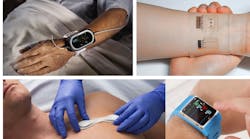The future of healthcare could be even more data-driven and personalized than it is today. In such a world, people would receive care on a frequency determined by their own unique situations, rather than an arbitrarily set cadence. But such a future requires both patients and doctors to be equipped to more closely monitor and communicate any changes in chronic conditions as well a be more proactive about preventive care.
With the array of continuous-monitoring wearables already on the market or in a prototyping or R&D phase, technologists are certainly continuing to push the envelope in terms of the types of data that could be collected non-intrusively. And medical professionals are stepping into the digital health world. However, we’re still only taking baby steps toward personalized, decentralized healthcare. After all, it takes a lot of recorded data, associated with ground truths, before this information can be distilled into insights that could be applied to future data.
For example, to develop algorithms that accurately interpret a given data set as steps, researchers had to collect data from pedestrians on a variety of parameters: ages, weights, and stride lengths; different types of shoes worn; and their walking patterns on different surfaces and inclines and at different speeds. In addition, they had to gather other data not associated with any steps to make sure that the algorithms won’t falsely interpret them as steps.
To say that we can get personal health insight from continuous monitoring presumes a “chain of trust.” In other words:
- The interpretation of any data must not only be accurate but reliable. The challenge lies in handling “borderline” data. Any interpreting strategy or algorithm faces data sets that it finds ambiguous. For an algorithm to be reliable, users must be able to quantitatively understand its detection limits and error characteristics.
- The data and/or its interpretation must reliably reach the decision-maker for it to become actionable.
- The data must be correctly associated with historical records of the patient for it to have context.
- The data must be proven to be authentic to trigger any meaningful action.
Could Data from Wearables Ever Augment Clinical Data?
Global shipments of wearable products are expected to exceed 200 million units this year. What’s more, the devices continue to grow more sophisticated in function, monitoring parameters such as blood-oxygen levels, blood-glucose levels, and electrodermal activities. Given all of this, what needs to happen for wearable healthcare devices to attain a level of trust so that they could augment clinical data to inform healthcare decisions?
First off, wearables will need to be more ingrained into the everyday lives of even more people. To reach this level, they’ll need to capture useful data accurately, unobtrusively, and comfortably. Addressing these factors involves system and mechanical design.
For example, the biosensors that are key to data capture must be able to overcome measurement challenges related to skin tone, sweat, blood perfusion, and other biological factors. The devices should also be small and operate for long periods between charges without running too hot.
One key initial step toward bringing wearables into the patient-care fold is to establish baselines that can serve as guidance of accuracy. This would involve comparing data collected by wearables to data gathered using clinical equipment in a controlled setting for a population of people. The clinically derived data would serve as the truth to validate the accuracy of the wearable data.
However, using clinical equipment to capture vital signs that are representative of the wearable use cases is often difficult and sometimes inaccurate. To avoid a rash of false positives or false negatives, one must carefully select the population of test subjects and carefully develop the representative use cases. It’s also important to compare data from the patient’s own history or baseline, keeping in mind that this baseline isn’t static as the patient ages and undergoes other changes.
There’s also the matter of privacy to address—this may be the proverbial “elephant in the room.” Patients must feel confident that their personal data will be used as intended. Doctors, of course, must feel assured that they can trust the data on which they base their diagnoses. In traditional healthcare environments, doctors, hospitals, testing facilities, and equipment are well-certified. But this isn’t yet the case for most wearable devices. Recently, some disposable monitoring devices have been adopted for pre- and post-operative care, so this is a start.
Clearly, much needs to happen on the technology and medical community sides for healthcare wearables to become key components in patient care. For additional insights into how we can establish the chain of trust for wearables, read my blog, “How Wearables Can Become a More Integral Part of Healthcare.”
Ian Chen is the Executive Director of the Industrial & Healthcare Business Unit at Maxim Integrated.
